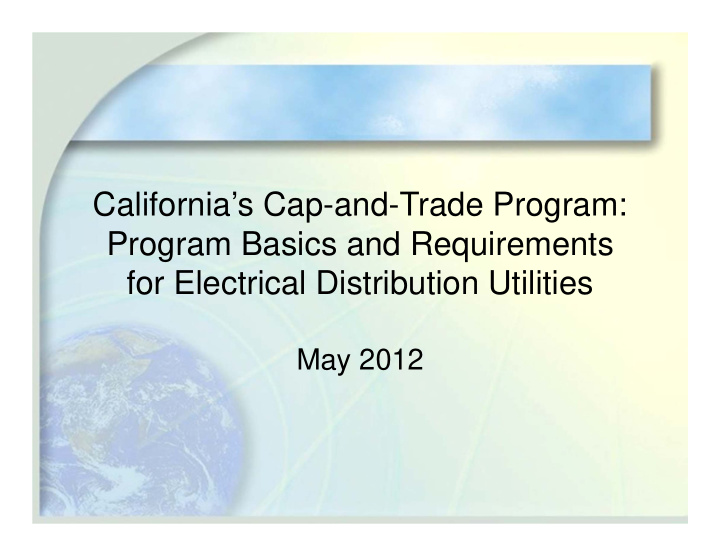



California’s Cap-and-Trade Program: Program Basics and Requirements for Electrical Distribution Utilities May 2012
What is Cap and Trade? • A market-based mechanism that places a “cap” on greenhouse gas (GHG) emissions from covered sources. The cap declines over time to achieve economy-wide emissions reductions. • Part of a suite of complementary measures (including the Renewables Portfolio Standard and Low Carbon Fuel Standard, among others) that will collectively reduce GHG emissions to 1990 levels by 2020 • Participants are required to surrender one compliance instrument (allowances and offsets) for each metric ton of covered GHG emissions • Compliance instruments may be traded 2
Who is Covered under the Cap-and-Trade Program? • Starting in 2012, stationary sources emitting at or above 25,000 metric tons of CO 2 e per year – Large industrial sources – Electricity generation and importers of electricity • Beginning in 2015, combustion from smaller emissions sources will be captured by assessing a compliance obligation on upstream fuel suppliers – Transportation fuels – Residential and commercial use of natural gas 3
What is Required of Covered Entities? • Register with ARB • Report and verify GHG emissions annually • Surrender compliance instruments to match covered emissions at the end of each compliance period • Comply with recordkeeping and market rules, as well as with other program requirements 4
Mandatory Reporting Regulation Timeline for Electrical Distribution Utilities • Feb 1: Deadline for registering specified sources • April 10: Deadline to submit previous year’s GHG emissions report for in-state power plants • Jun 1: Deadline to submit previous year’s GHG emissions report for imported electricity • Sep 1: Deadline to verify emissions 5
Cap-and-Trade Program Timeline: 2012 • Sep 1: POUs and co-ops must inform ARB of allowance placement into Compliance Account or Limited Use Holding Account • Sep 14: Allocation to electrical distribution utilities for vintage 2013 allowances • Mid-Sep: Notice of November 14th auction • Mid-Oct: Auction participant application deadline • Early Nov: Deadline to submit bid guarantee • At least ten days prior to auction: Deadline to consign allowances to auction • Nov 14: Auction 6
Cap-and-Trade Program Timeline: 2013–2021 Auctions: 12 th business day of Feb, May, Aug, and Nov, • 2013–2020 Reserve sales: 1 st business day 6 weeks after each • quarterly auction, 2013–2020 • June 1, 2014–2021: Attestation of no resource shuffling • June 30, 2014–2021: Report on use of auction proceeds • Sep 1, 2013–2020: Deadline for POUs and co-ops to report on allowance account placement for allocation • Nov 1, 2014–2021: Surrender of compliance instruments • Nov 1, 2013–2019: Allocation of allowances to electrical distribution utilities for the next vintage year 7
Registration and the Tracking System • Register with the Compliance Instrument Tracking System Service (CITSS) – Registration will open summer 2012 • Primary Account Representative and Alternate(s) – Legal authority to act on behalf of entity • Three account types applicable to program participants – Holding Account – Compliance Account – Limited-Use Holding Account (specific to electrical distribution utilities) 8
Quarterly Auctions: 2013–2020 • Occur on the 12 th business day of the second month of each quarter • Bidding occurs on the day of the auction • 40% purchase limit for current vintage allowances • 25% purchase limit for future vintage allowances 9
Quarterly Auctions (continued) • 75 days prior: Consign allowances to auction – Must annually consign all current and prior vintage allowances in Limited Use Holding Account • 60 days prior: Auction will be noticed • 30 days prior: Auction participant applications due • 12 days prior: Bid guarantees due (bond, cash, or letter of credit) 10
Price-Containment Reserve Sales: 2013–2020 • First sale: March 8, 2013 • Subsequent sales occur on the first business day six weeks after each quarterly auction • Three fixed-price tiers (in 2013: $40, $45, and $50) • Prices adjust annually for inflation and 5% real appreciation • 12 days prior: Bid guarantees due (bond, cash, or letter of credit) 11
Annual Allocation: 2013–2019 • IOUs must consign all allowances to auction • POUs may distribute allowances between: – Compliance Account of generation facility owned by • Utility or cooperative • Joint power authority – Limited Use Holding Account (consign to auction) • POUs must inform ARB how to distribute allowances amongst accounts by Sep 1 12
Annual Allocation (continued) • Allowances are distributed to electrical distribution utilities for the benefit of ratepayers • Annual allocations by electrical distribution utility can be found in table 9-3 of the regulation Example of a utility’s allocation calculation of vintage 2013 allowances distributed in 2012 Utility’s Share Annual Sector Allocation Utility’s Allocation 15% 97.7 MMT 0.981 14,376,555 Utility' From table 9 ‐ 3 Base Allocation From table 9 ‐ 2 2013 Allowances 13
Compliance Obligation Surrender: 2014–2021 • Compliance obligation calculated from reported and verified emissions per section 95852 of the regulation • Three compliance periods: 2013–2014, 2015–2017, and 2018–2020 • Annual Surrender: Nov 1, 2014, 2016, 2017, 2019, and 2020 – Surrender instruments equal to 30% of the previous year’s emissions with a compliance obligation (based on the reported data) • Triennial Surrender: Nov 1, 2015, 2018, and 2021 – Surrender instruments equal to its compliance period obligation minus what has previously been surrendered (based on verified data) 14
Use of Offsets as Compliance Instruments • Each covered entity is limited to satisfying up to 8% of its total compliance obligation, per compliance period, with offset credits • No limit on the percentage of offsets that may be used to satisfy the annual 30% surrender requirement 15
Staying Informed • Register with Cap-and-Trade Program listserv to keep informed of additional information – http://www.arb.ca.gov/listserv/listserv_ind.php?listname= capandtrade • Register with tracking system – Available summer 2012 • Cap-and-Trade Program web site: – http://www.arb.ca.gov/cc/capandtrade/capandtrade.htm • Cap-and-Trade Program Hotline – (916) 322-2037 16
Recommend
More recommend